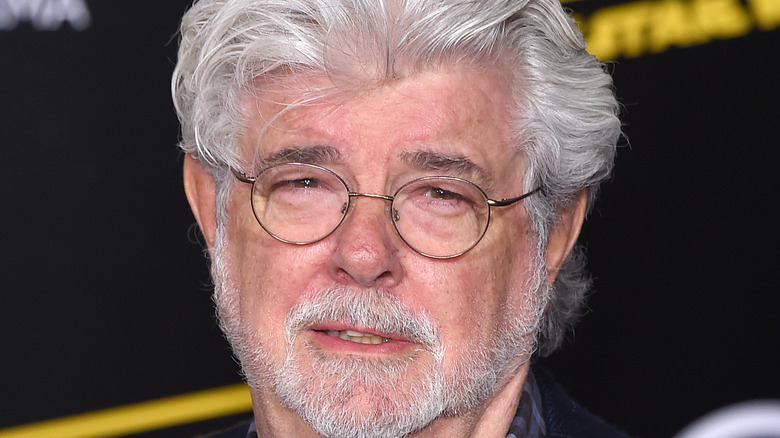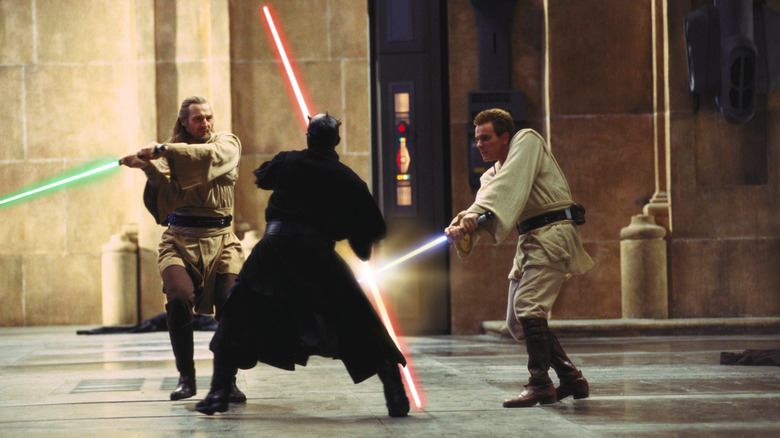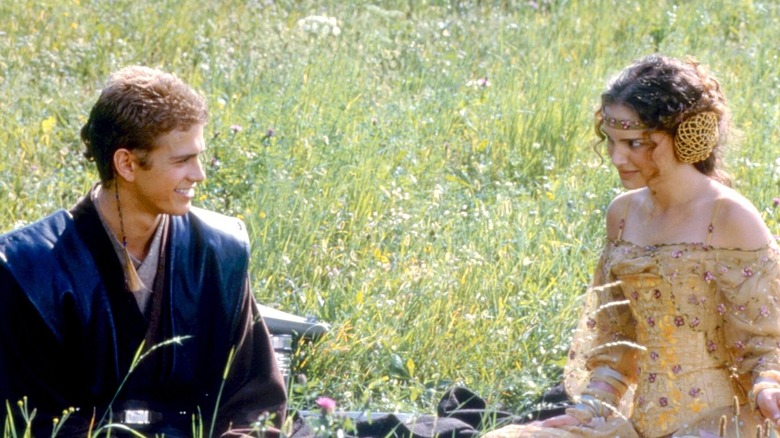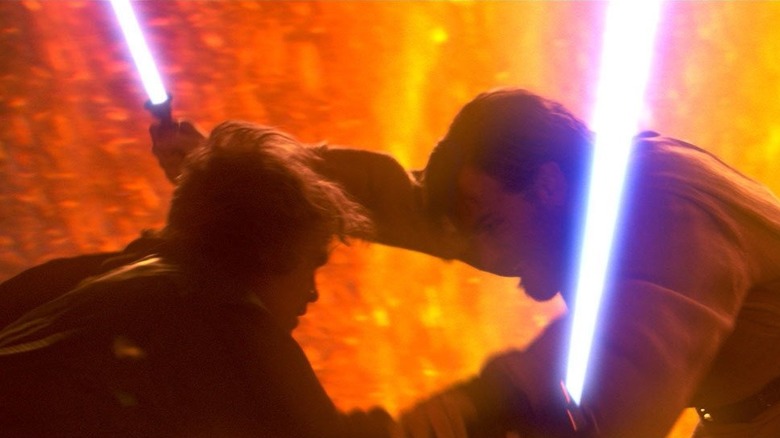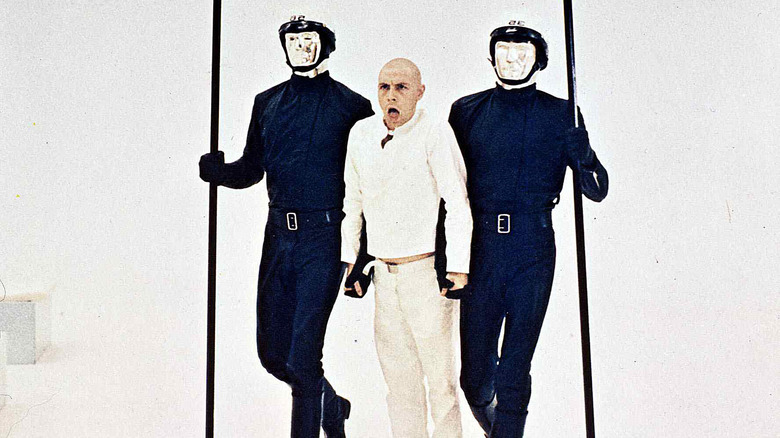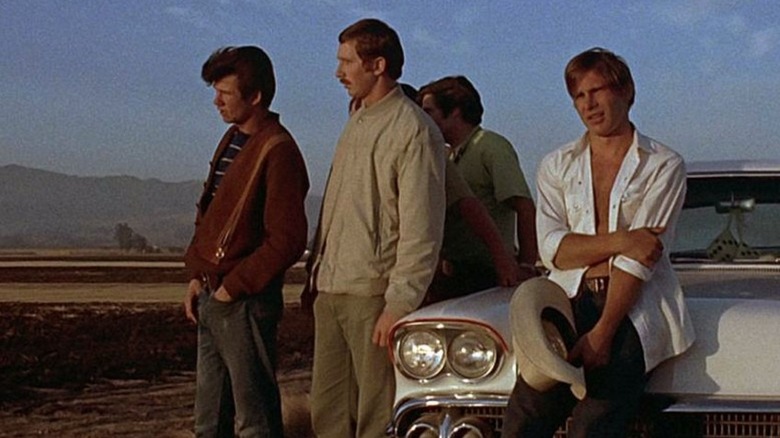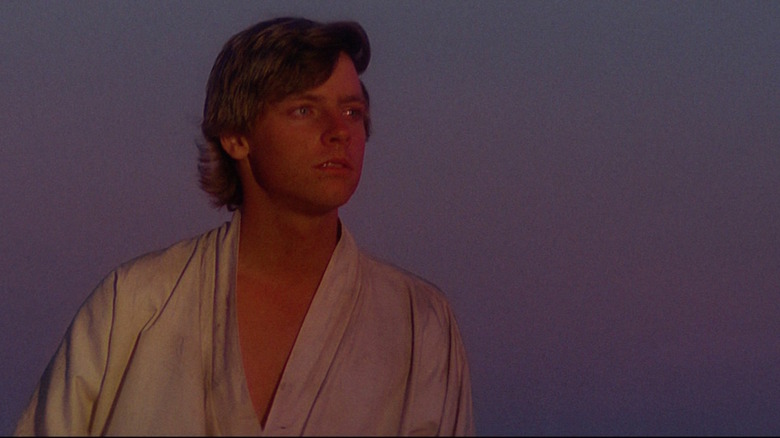Every George Lucas Directed Movie Ranked Worst To Best
Few people in the history of cinema have been quite as influential as George Lucas. Even sidestepping the grand cultural legacy of the "Star Wars" franchise for a moment, Lucas has paved the way for how modern film technology is presented, distributed, and considered, leading the way on cutting-edge techniques in digital filmmaking and immersive sound effects. Although Lucas is sometimes criticized for his overuse of computer-generated imagery, he nonetheless revolutionized the creation of fully CGI characters that appear alongside actors.
Then there's "Star Wars." Whether you're a fan or not, the franchise is among the most dominant and instantly recognizable trademarks in modern pop culture history, and it all began with the lightning in a bottle a young Lucas managed to capture. Although his role within the franchise's development has evolved in the decades since 1977, Lucas can take credit in some part for much of the content we see today.
What's surprising about Lucas is that while he's a household name when talking about iconic filmmakers, his work has largely been as a producer and writer. Lucas took a 22-year directing gap between the original "Star Wars: Episode IV" and the prequel "Star Wars" trilogies, and set about producing a variety of projects ranging from the runaway success of the "Indiana Jones" franchise to the all-out embarrassment of "Howard the Duck." The few films that Lucas directed are a fascinating skeleton key to exploring his complex legacy. Here is every George Lucas-directed movie ranked worst to best.
6. Star Wars: Episode I - The Phantom Menace (1999)
What's most remarkable about the "Star Wars" prequel trilogy is that the issues and criticisms that many level against the three films are the exact opposite of the qualms that many have with modern blockbuster filmmaking. Modern studio tentpoles tend to prioritize nostalgia to a fault and are so drowned out by studio influence that the voice of the filmmaker is harder to identify. Opinions vary drastically on the prequels, but they are unquestionably auteurist works that come from the singular mind of George Lucas. He wasn't interested in dredging up the past or conforming to preconceived expectations, and that in and of itself is worth celebrating.
"Star Wars: Episode I – The Phantom Menace" is a mess, but it's a film that's bursting with original and inventive ideas. Lucas wanted to paint the backstory of one of cinema's most iconic villains as a Shakespearean tragedy and, unfortunately, Anakin's journey often takes a backseat to an overcomplicated political backstory. It's unfair to blame Jake Lloyd or any of the actors involved, as the dialogue is challenging and largely expositional. Lucas often exposes moments of thematic resonance as blunt admissions rather than weighted conversations. At the same time, "The Phantom Menace" remains wildly entertaining in spots. The Darth Maul lightsaber duel, the pod race, and the underwater Naboo planet core escape are brilliantly directed action sequences that saw Lucas in his element and inspiring a whole new generation of fans.
5. Star Wars: Episode II - Attack of the Clones (2002)
"Star Wars: Episode II – Attack of the Clones" is perhaps the most underrated film in the entire franchise. The flaws are obvious, as Hayden Christensen and Natalie Portman have little-to-no chemistry while a good portion of the film slows the pace to focus on their burgeoning romance. The dialogue is overly sentimental and melodramatic, but it's odd to think that wasn't an active choice on George Lucas' part. Setting a "Romeo & Juliet"-style romance at the dawn of a devastating war is an interesting choice, as is showing the galaxy's most brutal villain as an awkward, insecure teenager unsure of how to express himself. While this can't redeem something like the "I hate sand" monologue, Lucas was clearly interested in the dramatic irony of this contrast.
"Attack of the Clones" is a film about the mechanisms that generate war, and it's interesting to consider how political Lucas has always been. In the early 21st century when the world itself faced larger questions about the future of warfare, Lucas turned his science fiction adventure into a grim look at how conflict sparks while a charismatic leader takes advantage of societal pressures to brew fascism. Someone as dull-minded as Jar Jar Binks may be responsible for the origins of the Galactic Empire. "Attack of the Clones" also features stunning set pieces, and the last 45 minutes set during the Battle of Geonosis are downright gripping.
4. Star Wars: Episode III - Revenge of the Sith (2005)
"Star Wars: Episode III – Revenge of the Sith" is the film George Lucas wanted to make since the inception of the prequel trilogy, fulfilling the tragedy of Darth Vader's seduction to the dark side of the force. While the previous two films didn't succeed in turning Anakin Skywalker into a likable character, seeing his downward spiral is nonetheless effective, even devastating. On a thematic level, Lucas' commentary is more focused than his previous installments, with some observations being eerily prescient. The line "So this is how democracy dies ... With thunderous applause" is a lot more impactful in 2022 than it was in 2005 considering real-world developments.
"Revenge of the Sith" flows much better as a film than its two predecessors. The action sequences are spread out more effectively, and the relationship between Anakin and Obi-Wan Kenobi is rightfully at the focus. Ewan McGregor's performance has always been a standout within the trilogy (despite the actor's personal reservations), and here he delivers his strongest work with a heartbreaking performance as a failed mentor. McGregor's final words to his former student as he leaves him for dead on the fiery dunes of Mustafar are tear-jerking. The film also benefits from a gloriously hammy performance by Ian McDiarmid as Chancellor Palpatine, chewing the scenery as Palpatine plants the seeds of doubt about the Jedi Order within Anakin's hapless mind. Romantic exchanges remain a challenge for Lucas, however.
3. THX-1138 (1971)
It's shocking to compare the stripped-down environments of George Lucas' 1971 debut feature "THX-1138" with the expensive, special effects-laden "Star Wars" prequels. Lucas has always worked at utilizing the furthest extent of his resources, regardless of whether they were limited in his early days or seemingly limitless once he grew powerful. "THX-1138" is a remarkable entry into the canon of '70s nihilistic science fiction films (which also include "A Clockwork Orange," "Soylent Green," and "Logan's Run"), with grave warnings about the future of society, technology, and fascism. On a thematic level, "THX-1138" is also quite similar to "Star Wars" as both are about a group of brave detractors who fight against incredible odds to oppose a dominant governmental body.
"THX-1138" was based on the 15-minute 1967 short film "Electronic Labyrinth: THX 1138 4EB," which he created while he was a film student at the University of Southern California and subsequently got him industry attention. The feature version expands the concept and allows Lucas to put more emphasis on worldbuilding. While the short primarily focuses on the ending chase sequence, Lucas places another tragic love story at the heart of his adventure. While the imagery is certainly not as iconic as the ones he'd create a few years later for a galaxy far far away, there's certainly a hypnotic quality to the stark white visuals and terrifying shock guards. Robert Duvall also delivers a strong performance as the titular character, who wants to be more than a number.
2. American Graffiti (1973)
It's always incredible to note the versatility of George Lucas' interests, even within his early career. Lucas' immediate follow-up to his austere, obtuse science fiction prophecy "THX-1138" is a film as wildly different as you can get: An exciting, crowd-pleasing, hilarious teen adventure about a group of lustful kids considering their future. Yet even within a film that's so tonally distinct and placed in an entirely different environment, Lucas returns to many of the recurring themes of "THX-1138" that he would bring to "Star Wars."
There's a grimness at the heart of "American Graffiti," as the characters are celebrating the precious time they have left together before their lives are overtaken by the cynical nature of adulthood. The threat of the Vietnam War looms in the background, and Lucas concludes the film with a shocking title card that reveals all of the characters' eventual fate in the coming years. While it's a celebration of the cultural renaissance of the United States in the 1960s, inspired heavily by Lucas' own experiences growing up in Modesto, it's also a painful reminder that many of the most endearing elements were never meant to last.
Even within "American Graffiti," Lucas utilized groundbreaking technological advances. The incorporation of the film's Top 40 rock and roll soundtrack is brilliantly handled, and setting the entire story over the course of one night creates some truly electrifying chase sequences. It's also the best screenplay of Lucas' career, with naturalistic teen banter and charismatic characters.
1. Star Wars: Episode IV - A New Hope (1977)
It was always going to be "Star Wars." Without a doubt, "Star Wars: Episode IV – A New Hope" is a cornerstone American classic, and stepping aside from the film's vast cultural legacy and the achievements of the franchise over the next four decades, as an individual film it's pretty much perfect ... regardless of the many annoying CGI changes George Lucas has added to the subsequent home releases.
Even compared to the other "Star Wars" films, there's something that feels signature to Lucas within the first film. "The Empire Strikes Back" may be more gripping on a dramatic level, "Return of the Jedi" may be more relentlessly entertaining, "The Force Awakens" may be more emotional, and "The Last Jedi" may be more thematically rich, but there's a joyous simplicity to "A New Hope." As much as it was the introduction of an exciting world, it's also a fairy tale and one of the most personal in the saga. There are echoes of all of Lucas' heroes within Luke Skywalker: His yearnings about the future, the stresses of his environment, and his growing interest in opposing the forces of evil. These are qualities shared with the lonely title character of "THX-1138," the rambunctious teenagers of "American Graffiti," and George Lucas himself.
"Star Wars" inspired a generation of young filmmakers to take an interest in movies, and generations later one must still marvel at the film's ability to excite and inspire.
